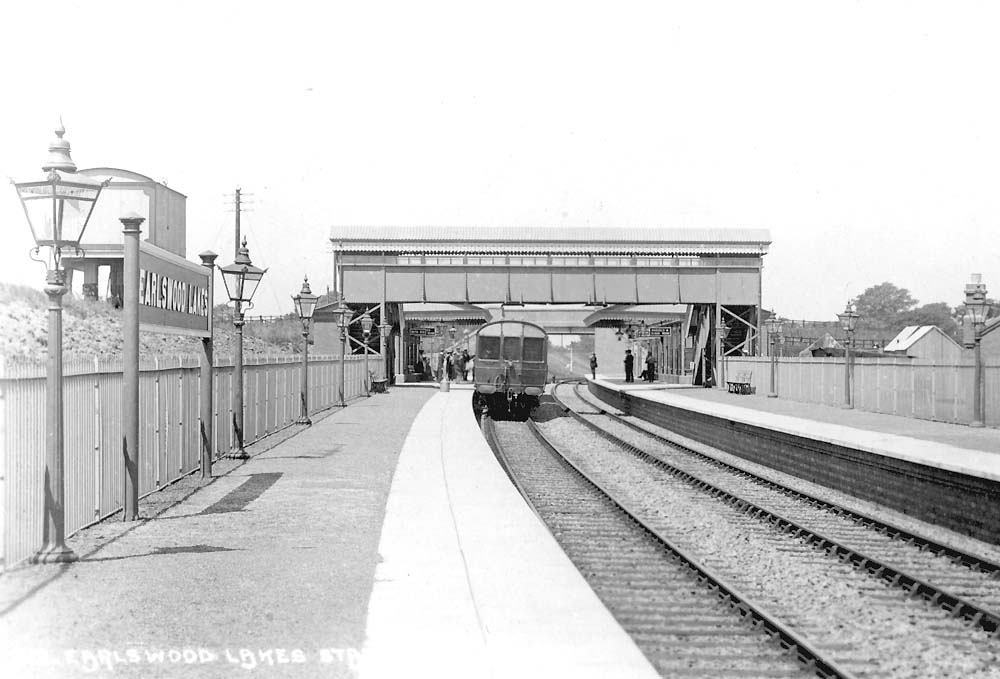 |
|
GWR Route: North Warwickshire Line
Earlswood Lakes Station: gwrel2863
 |
GWR No 26 Steam Rail Motor is seen standing at the up
platform at Earlswood Lakes within a few weeks of opening in July 1908. In
1902, the GWR was meeting increased competition in suburban areas from electric
streetcar trams and horse-drawn buses. To counter this the Great Western
decided to introduce steam powered rail-cars so that more frequent services of
small passenger numbers could be provided on both suburban and country branch
lines. Trials took place in early 1903 with a Dugald Drummond rail motor which
he had designed for the joint LSWR/LBSCR East Southsea service. As a result of
these trials the first Great Western rail steam car came into service on the
12th October 1903. They featured an open saloon type interior with seats on
either side of a central aisle, however only one class was catered for and some
of them had a section partitioned off for non-smokers. At one end of the car
was the driving bogie whilst the other end was carried on a eight foot bolster
bogie which, for the first time, replaced the Dean suspension bogie. The
vertical boiler, working at a pressure of 160 p.s.i., was mounted on the
underframe of the driving bogie. The outside cylinders were 12 inches diameter
and 16 inches stroke and drove a pair of 3 feet 6 inch diameter wheels, whilst
slide valve were operated by Walschaerts valve gear.
In the early cars there was a vestibule at the trailing end
by which the passengers entered and left the car. There was also a position for
the driver in the vestibule for use when the car was running with the engine in
the rear. The first two cars operated on the busy Stroud Valley line between
Chalford and Stonehouse and at level crossings, folding steps were released at
the vestibule end so that passengers could get on or off. Due to safety
concerns, the level crossing stop was replaced by short platforms called
'halts' which had easy access from a public road. The services became very
popular and before long led to the construction or expansion of housing estates
close to the halts. So many extra passengers were attracted that, during busy
periods of the day, trailer cars were attached with seating similar to that of
the steam cars and with a driving compartment at the end of the trailer car
fitted with duplicate controls. The very popularity of the cars led eventually
to their replacement as the engine was too small to tackle the extra weight of
the trailer car on many of the routes. Auto-trains were therefore introduced
from 1905 to replace the steam cars where the traffic had got beyond their
capacity. An ordinary tank engine such as a Wolverhampton 517 class 0 - 4 - 2,
was fitted with controls which could be extended as required. It had sufficient
power to work four coaches, two in front and two behind and it could run at a
higher speed than the 30 mph maximum of the steam car. This was the early
development of the auto-train which later used the '14xx' 0-4-2 and '54xx'
0-6-0 class engines.
All of the fleet were built with four-wheel vertical-boiler
power units and a four-wheel trailing bogie under the carriage. Driving wheels
were from 3 ft 5in to 4 ft 0in; cylinders were from 9in × 15in to 12in
× 16in.
Courtesy
The Great Western Archive.
Photographer George E Lewis
 back back

|
